|
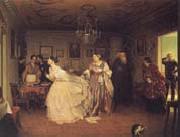 |
Pavel Fedotov
|
|
1815-1852 Realism Russian Russian painter and draughtsman. He was noted for his satirical critique of Russian life of the mid-19th century. He attended the First Moscow Military School (1826-33), then served in St Petersburg in the Finnish Regiment Life-Guards. While earning a reputation as an honest and hard-working officer, he drew a great deal, played the flute and took part in amateur theatrical performances. Having become established as the regimental artist, in 1834 he began to attend evening classes at the St Petersburg Academy of Arts. In November 1843, after a long period of doubt, he resigned his commission in the army in order to become a professional artist. He began to attend the Academy regularly and joined the battle-painting class of Aleksander Zauerveid (1783-1844), |
 |
Pavel Chistyakov
|
|
(July 5 [O.S. June 23] 1832 - November 11, 1919) was a Russian painter and teacher of art.
He studied at the St.Petersburg Academy of arts (1849-1861) under Petr Basin. He was a pensioner of the Academy of Arts in Paris and in Rome (1862?C1870). He taught in the Drawing School of the Society for the Encouragement of the Arts (1860-1864), and in St.Petersburg (from 1872) he was the professor-head of workshop (1908-1910) and managing mosaic branch (1890-1912). The art-pedagogical system of Chistiakov, whose students included Viktor Vasnetsov, Mikhail Vrubel, Vasily Polenov, Ilya Repin, Valentin Serov, and Vasily Surikov, developed in constant struggle against the inert system of academism and played a huge role in the development of realism in Russian art of the second half of the 19th century.
The main goal of Chistiakov was the preparation of the artist-citizen possessing high professional skill. His pedagogical method assumed the merger of the direct perception of nature by the artist with its scientific study. In creative practice he aspired to dramatization of a historical plot and psychological saturation in historical and genre portraits (Head of a Ciucciara, 1864, in the Russian Museum, |
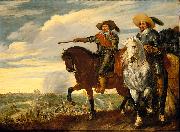 |
Pauwels van Hillegaert
|
|
(1596-1640) was a Dutch Golden Age painter of landscapes and military scenes.
He married Anneken Homis from Antwerp in 1620, with whom he had several children, including the painter with the same name, Pauwels van Hillegaert II (1621-1658). This Pauwels Jr. married Cornelia de Vlieger (daughter of Simon de Vlieger) and had two daughters. When Pauwels Jr. like his father died at a relatively young age, Cornelis de Bie wrote a commemorative poem about him.
Pauwels Sr. won royal commissions to paint battle scenes, most notably for the Siege of 's-Hertogenbosch in 1629. He also won a commission for the Battle of Nieuwpoort. He also painted Italianate landscapes, but was mostly admired for his horses and armor.
|
 |
Paulus Moreelse
|
|
(1571, Utrecht - 6 March 1638, Utrecht) was a Dutch painter, mainly of portraits.
Moreelse was a pupil of the Delft portrait painter Michiel Jansz. van Mierevelt, who had himself been a pupil of Anthonie van Blocklandt. He took a study-trip to Italy, where he received many portrait commissions. Back in Utrecht, in 1596 he became a member of the zadelaarsgilde, which was the traditional name in Utrecht for the Guild of Saint Luke. In 1611, along with Abraham Bloemaert, he was one of the founders of a new painters' guild, called "St. Lucas-gilde", and became its first deken.
Moreelse was a well known portrait painter who received commissions from right across the Dutch Republic. His earliest work dates to 1606. Other than portraits, he also painted a few history paintings in the Mannerist style and in the 1620s produced pastoral scenes of herders and shepherds. He belonged to the same generation as Abraham Bloemaert and Joachim Wtewael, and like Wtewael he played an important role in the public life of their city. His version of Diana and Callisto was engraved by Jan Saenredam. In 1618, when the anti-remonstrants came to power in Utrecht, he was raadslid.
|
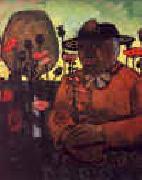 |
Paula Modersohn-Becker
|
|
German
1876-1907
Paula Becker was born and grew up in Dresden-Friedrichstadt. She was the third child of seven children in her family. Her father who was the son of a Russian university professor, was employed with the German railway. He and Modersohn-Becker's mother, who was from an aristocratic family, provided the children a cultured and intellectual environment in the house hold.
Modersohn-Becker's parental home 1888-1899In 1888 her parents moved from Dresden to Bremen. While visiting an aunt in London, England, she received her first instruction in drawing. Apart from her teacher's training in Bremen in 1893-1895, Paula took private instruction in painting. In 1896 she participated in a course for painting and drawing sponsored by the "Verein der Berliner K??nstlerinnen" (Union of Berlin Female Artists) which offered art studies to women.
Paula Modersohn-Becker. Clara Rilke WesthoffAt the age of 22, she encountered the artistic community of Worpswede. In this "village", artists such as Fritz Mackensen (1866-1953) and Heinrich Vogeler (1872-1942) had retreated to protest against the domination of the art academy and life in the big city. At Worpswede, Paula Modersohn-Becker took painting lessons from Mackensen. The main subjects were the life of the farmers and the northern German landscape. At this time she began close friendships with the sculptor Clara Westhoff (1875-1954) and the poet Rainer Maria Rilke (1875-1926). She also fell in love during this period, and in 1901 she married a fellow Worpswede painter, Otto Modersohn. In marrying Otto, she also became a stepmother to Otto's daughter, Elsbeth Modersohn, the child from his first marriage to Helene Modersohn, then deceased.
Paula Modersohn-Becker. Rainer Maria Rilke, 1906Between 1900 and 1907, Paula made several extended trips to Paris for artistic purposes, sometimes living separately from her husband, Otto. During one of her residencies in Paris, she took courses at the Ecole des Beaux-Arts. She visited contemporary exhibitions often, and was particularly intrigued with the work of Paul C??zanne. Other post impressionists were especially influential, including Vincent Van Gogh and Paul Gauguin. Fauve influences may also appear in such works as Poorhouse Woman with a Glass Bottle. The influence by the work of French painter, Jean-Francois Millet, who was widely admired among the artists in the Worpswede group, may be seen in such pieces as her 1900 Peat Cutters.
Reclining Mother and ChildIn her last trip to Paris in 1906, she produced a body of paintings from which she felt very great excitement and satisfaction. During this period of painting, she produced her initial nude self-portraits (something surely unprecedented by a female painter) and portraits of friends such as Rainer Maria Rilke and Werner Sombart. Some critics consider this period of her art production to be the strongest and most compelling.
Paula with Mathilde, November 1907 (days before Paula's death)In 1907, Paula Modersohn-Becker returned to her husband in Worpswede. Their relationship, which had been particularly strained in 1906, had taken a turn towards improvement. Paula's long-lived wish to conceive and bear a child was fulfilled. Her daughter Mathilde (Tillie) Modersohn was born on November 2, 1907. Paula and Otto were joyous. Sadly, the joy became soon overshadowed by tragedy, as Paula Modersohn-Becker died suddenly in Worpswede on November 20th from an embolism.
In 1908, Rainer Maria Rilke wrote the renowned poem, "Requiem for a Friend", in Paula's memory. The poem was born of the imprint that Paula's life, death and friendship left upon Rilke. |
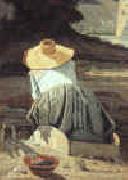 |
Paul-Camille Guigou
|
|
1834-1871
French
Paul Camille Guigou Gallery
French painter. Born into a family of landowners, he became a notary's clerk at Apt in 1851 and then in 1854 at Marseille. He learnt to paint with Camp, a teacher at the school in Apt, and then at Marseille with Emile Loubon (1809-63), director of the local Ecole des Beaux-Arts, who urged him (according to Guigou's biographers) to paint directly from nature. Guigou settled in Marseille in 1854, where he participated regularly in the annual Salon of the Societe Artistique des Bouches-du-Rhene. Guigou painted almost exclusively Proven?al landscapes, which were influenced by the works of the Barbizon painters, who exhibited in Marseille, and by the brownish tones and picturesque figures of Loubon's paintings. The Road to Gineste (1859) and The Washerwoman (1860; both Paris, Mus. d'Orsay) reflect the independent tradition of Proveneal painting during the Second Empire, which was characterized by warm colouring and precise lighting used to separate and distinguish forms. His knowledge of the works of Gustave Courbet, acquired during a visit to Paris in 1859, doubtless increased his liking for broad technique and sincere vision, articulated in a strong and ordered construction of space: for example, The Gorges of the Luberon (c. 1861; Amiens, Mus. Picardie). |
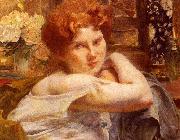 |
Paul-Albert Besnard
|
|
(2 June 1849 --4 December 1934) was a French painter and printmaker.
He was born in Paris and studied at the École des Beaux-Arts, studied with Jean Bremond and was influenced by Alexandre Cabanel. He won the Prix de Rome in 1874 with the painting Death of Timophanes
Until about 1880 he followed the academic tradition, but then broke away completely, and devoted himself to the study of colour and light as conceived by the Impressionists. The realism of this group never appealed to his bold imagination, but he applied their technical method to ideological and decorative works on a large scale, such as his frescoes at the Sorbonne, the Ecole de Pharmacie, the ceiling of the Comedie-Française (main theatre in Paris), the Salle des Sciences at the Hôtel de Ville, the mairie of the Ier arrondissement, and the chapel of Berck hospital, for which he painted twelve Stations of the Cross in an entirely modern spirit.
A great virtuoso, he achieved brilliant successes alike in watercolour, pastel, oil and etching, both in portraiture, in landscape and in decoration. His close analysis of light can be studied in his picture La femme qui se chauffe at the Luxembourg in Paris, one of a large group of nude studies of which a later example is Une Nymphe au bord de la mer; and in the work produced during and after a visit to India in 1911. A large panel, Peace by Arbitration, was completed seven days before the outbreak of war in 1914. |
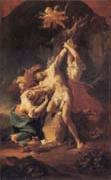 |
Paul Troger
|
|
Austrian Painter, 1698-1762
was an Austrian painter, draughtsman and printmaker of the late Baroque period. Troger's illusionistic ceiling paintings in fresco are notable for their dramatic vitality of movement and their palette of light colors. Paul Troger??s style, particularly in his frescoes, dominated Austrian painting until the end of the 18th century and profoundly influenced significant artists of the next generation, notably Franz Anton Maulbertsch, Josef Ignaz Mildorfer, Johann Wenzel Bergl. Paul Troger was born on October 30, 1698, in Welsberg, in the Puster Valley of Tyrol (now Bolzano-Bozen, Italy). At the age of 16, under the patronage of the aristocratic Tyrolean von Firmian family, he visited Fiume and became a pupil of Giuseppe Alberti.[2] He painted his first fresco ??Three Angels with the Cross and Putti??, in the Chiesa del Calvario, Kaltern am See/Caldaro al Lago, Bolzano, Italy (1722). In 1722, the prince-bishop of Gurk sent Paul Troger to Venice, where he discovered the works of Giovanni Battista Piazzetta, and Giovanni Battista Pittoni. Troger also studied in Rome with Sebastiano Ricci, in Naples with Francesco Solimena and in Bologna, the leading artistic centers of Italy at the time. On his return to Austria, Troger first worked in Salzburg from 1726 to 1728, where he painted the "Glory of Saint Cajetan" on the ceiling of St. Cajetan??s Church, Salzburg (1728). He afterwards established himself in Vienna, where the art of ceiling frescoes was, however, dominated by Johann Michael Rottmayr and Daniel Gran. Paul Troger became the favourite fresco painter in Lower Austrian monasteries in collaboration with the architect Josef Munggenast. In 1753, he joined the Imperial Academy of Fine Arts. |
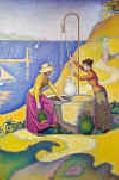 |
Paul Signac
|
|
1863-1935
French
Paul Signac Galleries
Paul Victor Jules Signac was born in Paris on November 11, 1863. He followed a course of training in architecture before deciding at the age of 18 to pursue a career as a painter. He sailed around the coasts of Europe, painting the landscapes he encountered. He also painted scenes of cities in France in his later years.
In 1884 he met Claude Monet and Georges Seurat. He was struck by the systematic working methods of Seurat and by his theory of colours and became Seurat's faithful supporter. Under his influence he abandoned the short brushstrokes of impressionism to experiment with scientifically juxtaposed small dots of pure colour, intended to combine and blend not on the canvas but in the viewer's eye, the defining feature of pointillism.
Many of Signac's paintings are of the French coast. He left the capital each summer, to stay in the south of France in the village of Collioure or at St. Tropez, where he bought a house and invited his friends. In March 1889, he visited Vincent van Gogh at Arles. The next year he made a short trip to Italy, seeing Genoa, Florence, and Naples.
The Port of Saint-Tropez, oil on canvas, 1901Signac loved sailing and began to travel in 1892, sailing a small boat to almost all the ports of France, to Holland, and around the Mediterranean as far as Constantinople, basing his boat at St. Tropez, which he "discovered". From his various ports of call, Signac brought back vibrant, colourful watercolors, sketched rapidly from nature. From these sketches, he painted large studio canvases that are carefully worked out in small, mosaic-like squares of color, quite different from the tiny, variegated dots previously used by Seurat.
Signac himself experimented with various media. As well as oil paintings and watercolours he made etchings, lithographs, and many pen-and-ink sketches composed of small, laborious dots. The neo-impressionists influenced the next generation: Signac inspired Henri Matisse and Andr?? Derain in particular, thus playing a decisive role in the evolution of Fauvism.
As president of the Societe des Artistes Ind??pendants from 1908 until his death, Signac encouraged younger artists (he was the first to buy a painting by Matisse) by exhibiting the controversial works of the Fauves and the Cubists. |
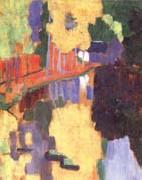 |
Paul Serusier
|
|
French Painter, 1863-1927
was a French painter who was a pioneer of abstract art and an inspiration for the avant-garde Nabi movement. He studied at the Academie Julian and was a monitor there in the mid 1880s. In the summer of 1888 he travelled to Pont-Aven and joined the small group of artists centered there around Paul Gauguin. While at the Pont-Aven artist's colony he painted a picture that became known as The Talisman, under the close supervision of Gauguin. The picture was an extreme exercise in Cloisonnism that approximated to pure abstraction. He was a Post-Impressionist painter, a part of the group of painters called Les Nabis. Serusier along with Paul Gauguin named the group. Pierre Bonnard, Edouard Vuillard and Maurice Denis became the best known of the group, but at the time they were somewhat peripheral to the core group. |
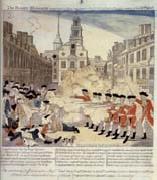 |
Paul Revere
|
|
American Sculptor and Engraver, 1735-1818
was an American silversmith and a patriot in the American Revolution. Because he was glorified after his death for his role as a messenger in the battles of Lexington and Concord, Revere's name and his "midnight ride" are well-known in the United States as a patriotic symbol. In his lifetime, Revere was a prosperous and prominent Boston craftsman, who helped organize an intelligence and alarm system to keep watch on the British military. Revere later served as an officer in one of the most disastrous campaigns of the American Revolutionary War, a role for which he was later exonerated. After the war, he was early to recognize the potential for large-scale manufacturing of metal. |
 |
Paul Raud
|
|
(22 October 1865 in Kirikukela, Viru-Jaagupi Parish C 22 November 1930 in Tallinn) was an Estonian painter. The twin brother of painter Kristjan Raud, he studied in Desseldorf beginning in 1886, becoming influenced by the work of Eduard Gebhardt. After his return to Estonia, he painted mainly portrait commissions for some time, before traveling with his brother and Amandus Adamson to the islands of Muhu and Pakri in 1896. His works of this period are reminiscent of those of Max Liebermann. In 1899 he returned to work in Germany, taking on some of the stylistic trappings of Impressionism; this, coupled with time spent working with Ilya Repin, influenced his later style. Later in his career, most especially during and after World War I, he began to teach, from 1915 working as a drawing instructor at the Tallinn Institute of Commerce and from 1923 at the State School of Industrial Art in Tallinn.
|
 |
Paul Ranson
|
|
French Nabi Painter, 1864-1909
French painter and designer. The son of a successful local politician, Ranson was encouraged from the outset in his artistic ambitions. He studied at the Ecoles des Arts D?coratifs in Limoges and Paris but transferred in 1886 to the Acad?mie Julian. There he met Paul S?rusier and in 1888 became one of the original members of the group known as the NABIS. From 1890 onwards, Ranson and his wife France hosted Saturday afternoon meetings of the Nabis in their apartment in the Boulevard du Montparnasse, jokingly referred to as 'Le Temple'. Ranson acted as linchpin for the sometimes dispersed group. Noted for his enthusiasm and wit and for his keen interests in philosophy, theosophy and theatre, he brought an element of esoteric ritual to their activities. For example he introduced the secret Nabi language and the nicknames used familiarly within the group. |
 |
Paul Philippoteaux
|
|
artist, born in Paris, France, 27 January, 1846
was a French artist. He is best known for a cyclorama of the Battle of Gettysburg.Paul Philippoteaux was born in Paris, the son of the French artist Henri Emmanuel Felix Philippoteaux. His education was at the Coll??ge Henri-IV, the École des Beaux-Arts in Paris, and in the studio of his father, as well as the studios of Leon Cogniet, and Alexander Cabanal. He became interested in cycloramas and in collaboration with his father created The Defence of the Fort d'Issy in 1871. Other works included Taking of Plevna (Turko-Russian War), the Passage of the Balkans, The Belgian Revolution of 1830, Attack in the Park, The Battle of Kars, The Battle of Tel-el-Kebir, and the Derniere Sortie.He was commissioned by a group of Chicago investors in 1879 to create the Gettysburg cyclorama. He spent several weeks in April 1882 at the site of the Gettysburg Battlefield to sketch and photograph the scene, and extensively researched the battle and its events over several months. Local photographer William H. Tipton created a series of panoramic photographs shot from a wooden tower erected along present-day Hancock Avenue. The photos, pasted together, formed the basis of the composition. Philippoteaux also interviewed several survivors of the battle, including Union generals Winfield S. Hancock, Abner Doubleday, Oliver O. Howard, and Alexander S. Webb, and based his work partly on their recollections.Philippoteaux enlisted a team of five assistants, |
 |
Paul Peel
|
|
(7 November 1860 - 3 October 1892) was a Canadian academic painter. Having won a medal at the 1890 Paris Salon, he became one of the first Canadian artists to receive international recognition in his lifetime.
Peel was born in London, Ontario, and received his art training from his father from a young age. Later he studied under William Lees Judson and at the Pennsylvania Academy of the Fine Arts under Thomas Eakins. He later moved to Paris, France where he received art instruction at the Ecole des Beaux-Arts under Jean-Leon Gerôme and at the Academie Julian under Benjamin Constant, Henri Doucet and Jules Lefebvre.
In 1882 he married Isaure Verdier and had two children with her: a son (Robert Andre, in 1886) and a daughter (Emilie Marguerite, in 1888).
Peel travelled widely in Canada and in Europe, exhibiting as a member of the Ontario Society of Artists and the Royal Canadian Academy. He also exhibited at international shows like the Paris Salon, where he won a bronze medal in 1890 for his painting After the Bath. He was known for his often sentimental nudes and for his pictures of children. |
 |
Paul Kane
|
|
(September 3, 1810 - February 20, 1871) was an Irish-born Canadian painter, famous for his paintings of First Nations peoples in the Canadian West and other Native Americans in the Oregon Country.
A largely self-educated artist, Kane grew up in Toronto (then known as York) and trained himself by copying European masters on a study trip through Europe. He undertook two voyages through the wild Canadian northwest in 1845 and from 1846 to 1848. The first trip took him from Toronto to Sault Ste. Marie and back. Having secured the support of the Hudson's Bay Company, he set out on a second, much longer voyage from Toronto across the Rocky Mountains to Fort Vancouver and Fort Victoria in the Columbia District, as the Canadians called the Oregon Country. |
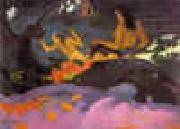 |
Paul Gauguin
|
|
French
1848-1903
Paul Gauguin Art Locations
(born June 7, 1848, Paris, France ?? died May 8, 1903, Atuona, Hiva Oa, Marquesas Islands, French Polynesia) French painter, sculptor, and printmaker. He spent his childhood in Lima (his mother was a Peruvian Creole). From c. 1872 to 1883 he was a successful stockbroker in Paris. He met Camille Pissarro about 1875, and he exhibited several times with the Impressionists. Disillusioned with bourgeois materialism, in 1886 he moved to Pont-Aven, Brittany, where he became the central figure of a group of artists known as the Pont-Aven school. Gauguin coined the term Synthetism to describe his style during this period, referring to the synthesis of his paintings formal elements with the idea or emotion they conveyed. Late in October 1888 Gauguin traveled to Arles, in the south of France, to stay with Vincent van Gogh. The style of the two men work from this period has been classified as Post-Impressionist because it shows an individual, personal development of Impressionism use of colour, brushstroke, and nontraditional subject matter. Increasingly focused on rejecting the materialism of contemporary culture in favour of a more spiritual, unfettered lifestyle, in 1891 he moved to Tahiti. His works became open protests against materialism. He was an influential innovator; Fauvism owed much to his use of colour, and he inspired Pablo Picasso and the development of Cubism.
|
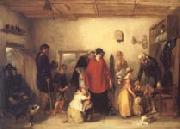 |
Paul Falconer Poole
|
|
(1806 - 1879) , an English painter born in Bristol
an English painter born in Bristol.was an English painter born in Bristol. Though self-taught his fine feeling for colour, poetic sympathy and dramatic power gained for him a high position among British artists. He exhibited his first work in the Royal Academy at the age of twenty-five, the subject being The Well, a scene in Naples. There was an interval of seven years before he next exhibited his Farewell, Farewell in 1837, which was followed by the Emigrant's Departure, Hermann and Dorothea and By the Waters of Babylon. In 1843 his position was made secure by his Solomon Eagle, and by his success in the Cartoon Exhibition, in which he received from the Fine Art Commissioners a prize of 300 sterling. After his exhibition of the Surrender of Syon House he was elected an associate of the Royal Academy in 1846, and was made an academician in 1861. Poole's subjects divide themselves into two orders, one idyllic, the other dramatic. Of the former his May Day (1852) is a typical example. Of both styles there were excellent examples to be seen in the small collection of his works shown at Burlington House in the Winter Exhibition of 1883-1884. Among his early dramatic pictures was Solomon Eagle exhorting the People to Repentance during the Plague of 1665, painted in 1843. To this class belongs also the Messenger announcing to Job the Irruption of the Sabeans and the Slaughter of the Servants (exhibited in 1850), and Robert, Duke of Normandy .and Arietta (1848). Finer examples of his more mature power in this direction are to be found in his Prodigal Son, painted in. 1869; the Escape of Glaucusand lone with the blind girl Nydia from Pompeii (1860); and Cunstaunce sent adrift by the Constable of Alia, King of Northumberland, painted in 1868. More peaceful than these are the Song of Troubadours (painted in 1854) and the Goths in Italy (1851), the latter an important historical work of great, power and beauty. Of a less lofty strain, but still more beautiful in its workmanship, is the Seventh Day of the Decameron, painted in 1857. In this picture Poole rises to his full height as a colourist. In his pastorals he is soft and tender, as in the Mountain Path (1853), the Water-cress Gatherers (1870), the Shepston Maiden (1872). But when he turns to the grander and more sublime views of nature his work is bold and vigorous. |
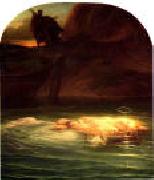 |
Paul Delaroche
|
|
1797-1856
French
Paul Delaroche Locations
Painter and sculptor, son of Gregoire-Hippolyte Delaroche. Though he was offered a post in the Bibliotheque Nationale by his uncle, Adrien-Jacques Joly, he was determined to become an artist. As his brother Jules-Hippolyte was then studying history painting with David, his father decided that Paul should take up landscape painting, and in 1816 he entered the Ecole des Beaux-Arts to study under Louis-Etienne Watelet (1780-1866). Having competed unsuccessfully for the Prix de Rome for landscape painting, he left Watelet studio in 1817 and worked for a time with Constant-Joseph Desbordes (1761-1827). In 1818 he entered the studio of Antoine-Jean Gros, where his fellow pupils included Richard Parkes Bonington, Eugene Lami and Camille Roqueplan. |
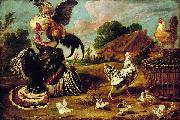 |
Paul de Vos
|
|
(1591e1592, or 1595, Hulst-30 June 1678, Antwerp) was a Flemish Baroque painter.
De Vos was born in Hulst near Antwerp, now in the Dutch province of Zeeland. Like his older brother Cornelis and younger brother Jan, he studied under the little-known painter David Remeeus (1559-1626). He specialized in monumental animal scenes, especially hunts for aristocratic patrons, that are heavily influenced by Frans Snyders (to whom his sister Margaretha was married). De Vos became a master and joined the guild of St. Luke in 1620.
As was frequent amongst artists in Antwerp, De Vos frequently collaborated with other painters. He painted animals in hunting scenes and armor in mythologies by Peter Paul Rubens and his studio. He also worked with Thomas Willeboirts Bosschaert, Erasmus Quellinus II, Anthony van Dyck, and Jan Wildens.
|
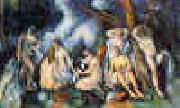 |
Paul Cezanne
|
|
French Post-Impressionist Painter, 1839-1906
During the second half of the 19th century French impressionism created a dramatic break with the art of the past. In conception and appearance the style was radically new and, although it initially inspired public ridicule, it soon affected nearly every ambitious artist in western Europe. The new vision emerged during the 1870s, chiefly in the art of Claude Monet, Auguste Renoir, and Camille Pissarro. For each of these artists impressionism was an illusionistic style which differed from the tradition of Renaissance illusionism in its greater emphasis upon vibrant, natural color and on an immediate confrontation with the phenomena of the visible world.
As the style developed during the 1880s, however, it increasingly became characterized by paintings which were flat rather than illusionistic. In other words, the impressionists insistence upon a direct application of pigment to canvas resulted in surfaces which declared themselves first of all as surfaces - and, consequently, in paintings which declared themselves first of all as paintings rather than as windows which looked out upon the natural world.
The tendency toward flatness persisted into the last years of the 19th century, its pervasiveness giving the impression that illusionistic space - fought for, won, and defended since the very beginning of the Renaissance - had finally been sacrificed by the medium of painting. Paul C??zanne worked within and finally emerged from this trend. As a painter, he matured slowly, his greatest works coming during the last 25 years of his life. During this period he scored a remarkable and heroic achievement: he restored to painting the space and volume that had seemingly been lost to it. But he did it in a totally unprecedented way: not by return to the illusionism of the past but by the creation of a spatial illusionism that did not violate flatness.
C??zanne was born on Jan. 19, 1839, in Aix-en-Provence. His father, Philippe Auguste, was the cofounder of a banking firm which prospered throughout the artist life, affording him financial security that was unavailable to most of his contemporaries and eventually resulting in a large inheritance. In 1852 C??zanne entered the Coll??ge Bourbon, where he met and became friends with Émile Zola. This friendship was decisive for both men: with youthful romanticism they envisioned successful careers in the Paris art world, C??zanne as a painter and Zola as a writer. Consequently, C??zanne began to study painting and drawing at the École des Beaux-Arts in Aix in 1856. His father opposed the pursuit of an artistic career, and in 1858 he persuaded C??zanne to enter law school at the University of Aix. Although C??zanne continued his law studies for several years, he was simultaneously enrolled in the School of Design in Aix, where he remained until 1861.
In 1861 C??zanne finally convinced his father to allow him to go to Paris. He planned to join Zola there and to enroll in the École des Beaux-Arts. But his application was rejected and, although he had gained inspiration from visits to the Louvre, particularly from the study of Diego Vel??zquez and Caravaggio, C??zanne experienced self-doubt and returned to Aix within the year. He entered his father banking house but continued to study at the School of Design.
The remainder of the decade was a period of flux and uncertainty for C??zanne. His attempt to work in his father business was abortive, and he returned to Paris in 1862 and stayed for a year and a half. During this period he met Monet and Pissarro and became acquainted with the revolutionary work of Gustave Courbet and Édouard Manet. C??zanne also admired the fiery romanticism of Eug??ne Delacroix paintings. But he was never entirely comfortable with Parisian life and periodically returned to Aix, where he could work in relative isolation. He retreated there, for instance, during the Franco-Prussian War (1870-1871). |
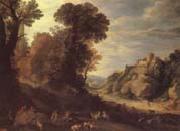 |
Paul Brill
|
|
Flemish painter , 1554-Rome 1626
were brothers, both born in Antwerp, who were landscape painters who worked in Rome after earning papal favor. They are also described as painters of capricci (whims or fancies) or vedute ideate or veduta di fantasia, with typical rustic hills with a few ruins. Mattheus began work on several frescoes in Rome from 1570 onwards, and his work includes the Vatican's Seasons. Mattheus died young, and his brother continued his work around 1574. Paul, a student of Damiaen Oertelmans, painted frescoes such as the landscapes in the Casino Rospigliosi (Rome), and The Roman Forum, which showed this site for what it had become: a slum for squatters and pasture for livestock (so much so that the place was nicknamed Campo Vaccino, or "The Cowfield"). His masterpiece may be a fresco in the Clementine Hall of the Vatican. Paul also did engravings and small cabinet paintings on copper, some of which are signed with a pair of spectacles (a pun on the French word brilles, "spectacles"). Some of these were collaborations with Johann Rottenhammer, who according to a dealer's letter of 1617 painted the figures in Venice and then sent the plates to Rome for Bril to complete the landscape. He collaborated with his friend Adam Elsheimer, who he both influenced and was influenced by, on one painting. |
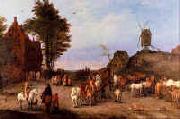 |
Paul Bril
|
|
Flemish Baroque Era Painter, ca.1554-1626
Paul (1554-1626) and Mattheus (1550-1583) Brill (or Bril) were brothers, both born in Antwerp, who were landscape painters who worked in Rome after earning papal favor. They are also described as painters of capricci (whims or fancies) or vedute ideate or veduta di fantasia, with typical rustic hills with a few ruins. Mattheus began work on several frescoes in Rome from 1570 onwards, and his work includes the Vatican Seasons. Mattheus died young, and his brother continued his work around 1574. Paul painted frescoes such as the landscapes in the Casino Rospigliosi (Rome), and The Roman Forum, which showed this site for what it had become: a slum for squatters and pasture for livestock (so much so that the place was nicknamed Campo Vaccino, or The Cowfield). His masterpiece may be a fresco in the Clementine Hall of the Vatican.
Paul also did engravings and small cabinet paintings on copper, some of which are signed with a pair of spectacles (a pun on the French word brilles, spectacles). Some of these were collaborations with Johann Rottenhammer, who according to a dealer letter of 1617 painted the figures in Venice and then sent the plates to Rome for Bril to complete the landscape. He collaborated with his friend Adam Elsheimer, who he both influenced and was influenced by, on one painting (now Chatsworth House) |
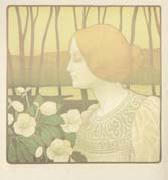 |
Paul Berthon
|
|
A truly gifted illustrator and poster artist ,
French , 1872-1909
French designer and lithographer. He began his training in Villefranche, where he studied painting, and in 1893 he moved to Paris, entering the Ecole Normale d'Enseignement du Dessin. There he became a pupil and disciple of Eug?ne-Samuel Grasset, the Professor of Decorative Arts, and was also influenced by Luc Olivier Merson. Berthon's main output consisted of posters and decorative panels. However, he also produced bookbindings and furniture designs, both of which he exhibited at the Salon in 1895; designs for ceramics for Villeroy & Boch in the late 1890s; and a few designs for the covers of such magazines as L'Image (July 1897) and Poster (May 1899). His work is in an Art Nouveau style, and he adopted that movement's plant and figural motifs, especially the motif of the femme fatale, and also its long sinuous lines. |
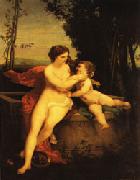 |
Paul Baudry
|
|
French Academic Painter, 1828-1886. Specializes in Portraits
Specializes in Portraits.was a French painter. He studied under Michel Martin Drolling and carried off the Prix de Rome in 1850 by his picture of Zenobia found on the banks of the Araxes. His talent from the first revealed itself as strictly academical, full of elegance and grace, but somewhat lacking originality. In the course of his residence in Italy Baudry derived strong inspiration from Italian art with the mannerism of Correggio, as was very evident in the two works he exhibited in the Salon of 1857, which were purchased for the Luxembourg: The Martyrdom of a Vestal Virgin and The Child. His Leda, St John the Baptist, and a Portrait of Beul, exhibited at the same time, took a first prize that year. Throughout this early period Baudry commonly selected mythological or fanciful subjects, one of the most noteworthy being The Pearl and the Wave (1862). Once only did he attempt an historical picture, Charlotte Corday after the murder of Marat (1861); and returned by preference to the former class of subjects or to painting portraits of illustrious men of his day: Guizot, Charles Garnier, Edmond About. The works that crowned Baudrys reputation were his mural decorations, which show much imagination and a high artistic gift for color, as may be seen. in the frescoes in the Paris Court of Cassation. at the château of Chantilly, and some private residences the Hôtel Fould and Hôtel Paivabut, above all, in the decorations of the foyer of the Opera Garnier. These, more than thirty paintings in all, and among them compositions figurative of dancing and music, occupied the painter for ten years. Baudry was a member of the Institut de France, succeeding Jean-Victor Schnetz. Two of his colleagues, |
 |
Paul Barthel
|
|
painted Interieur mit geoffneter Vitrine in 1862 - 1933 |
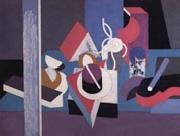 |
Patrick Henry Bruce
|
|
American Cubist Painter, 1881-1936
was an American cubist painter. A descendant of Patrick Henry, Bruce was born in Campbell County, Virginia, the second of four children. His family had once owned a huge plantation, Berry Hill, worked by over 3,000 slaves. Berry Hill is now a resort & conference center outside South Boston, Virginia and is now a National Historic Landmark. Berry Hill Estate originally was part of a 105,000-acre (420 km2) tract granted by the English Crown in 1728 to William Byrd II. The Civil War left the Bruce's wealth greatly diminished. Bruce began taking evening classes at the Art Club of Richmond in 1898, while working in a real estate office during the daytime. His earliest known extant painting dates from 1900. In 1902 he moved to New York, where he studied with William Merritt Chase, Robert Henri, and Kenneth Hayes Miller. By February 1904 he was in Paris, where he would live until 1933. Although his evolution toward a modernist style was gradual, his works of 1908 reveal the influence of Renoir and C??zanne, and in that year he was among the first to enroll in Matisse's school. Bruce exhibited regularly in the Salon d'Automne, and met many of the leading artists of the early twentieth century avant garde. |
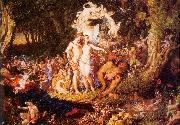 |
Paton, Sir Joseph Noel
|
|
English, 1824-1901
Scottish painter, illustrator, sculptor and collector. From his earliest years he drew avidly, seeking inspiration from ancient history, the Bible and from tales of romance and legend. His father was a keen antiquarian, and his habit of collecting items of historical interest and artistic merit was inherited by his son who amassed a collection, which included arms and armour, now in the National Museum of Scotland, Edinburgh. He used items from the collection in a large number of his paintings such as 'I wonder who lived in there?' (1867; Mrs Eva No?l Findlay priv. col.), the Fairy Raid (1867; Glasgow A.G. & Mus.), In die Malo (1881) and Oskold and the Ell? Maids (1874). After three years as head designer in one of the biggest sewn-muslin factories in Paisley, Strathclyde, Paton went to London in 1842. Although he did not take a studentship at the Royal Academy Schools, it was there that he met John Everett Millais, and they became lifelong friends. He won prizes in the Westminster Hall competitions in 1845 and 1847, |
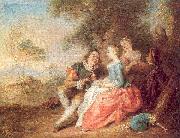 |
Pater, Jean-Baptiste
|
|
French Rococo Era Painter, 1695-1736
French painter and draughtsman. He was taught in Valenciennes by Jean-Baptiste Guid? (master 1697; d 1711) and also by his father, Antoine Pater (1670-1747), a sculptor whose portrait was painted by Antoine Watteau (Valenciennes, Mus. B.-A.), who was also a native of Valenciennes. He probably followed Watteau to Paris after the short stay that the latter made in Valenciennes around 1710. Pater thus became a pupil of Watteau. Watteau's difficult character led to Pater's dismissal. He then spent a few hard years on his own in Paris, before returning to Valenciennes around 1715 or 1716. He tried to work independently of the local corporation of St Luc, of which he was not a member; a number of comical legal difficulties ensued, and Pater returned to Paris in 1718. There he must have been in contact with Watteau, since he worked for some of the latter's clients, such as the dealers Pierre Sirois and Edm?-Fran?ois Gersaint, and the collector Jean de Jullienne. In the spring of 1721 the dying Watteau called Pater to him at Nogent, near Paris, apparently full of remorse for his previous attitude and wishing to instruct him in the basic tenets of his painting, |
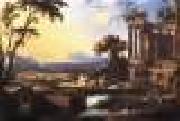 |
PATEL, Pierre
|
|
French Baroque Era Painter, ca.1605-1676
He dedicated himself exclusively to the art of landscape painting, and it is presumed that he spent his entire career in Paris, as there is no evidence to support claims that he went to Italy. In 1633-4 he was admitted to the guild of St Germain-des-Pres and in 1635 was admitted to the Academie de Saint-Luc. In 1651 he took part in a vain attempt to merge the Academie Royale and the Academie de Saint-Luc |
|

